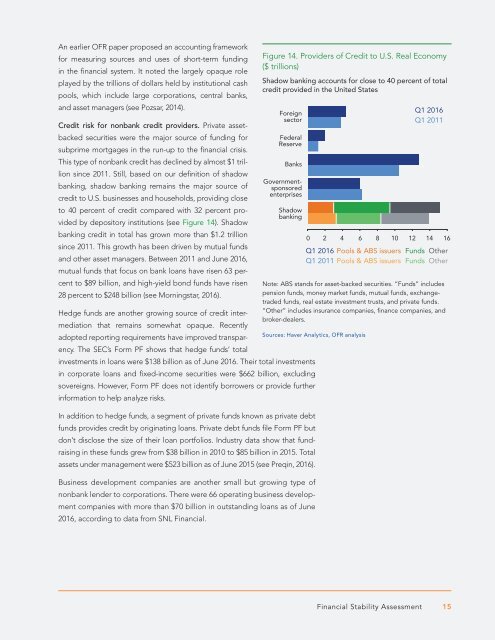OFR_2016_Financial-Stability-Report
OFR_2016_Financial-Stability-Report
OFR_2016_Financial-Stability-Report
Create successful ePaper yourself
Turn your PDF publications into a flip-book with our unique Google optimized e-Paper software.
An earlier <strong>OFR</strong> paper proposed an accounting framework<br />
for measuring sources and uses of short-term funding<br />
in the financial system. It noted the largely opaque role<br />
played by the trillions of dollars held by institutional cash<br />
pools, which include large corporations, central banks,<br />
and asset managers (see Pozsar, 2014).<br />
Credit risk for nonbank credit providers. Private assetbacked<br />
securities were the major source of funding for<br />
subprime mortgages in the run-up to the financial crisis.<br />
This type of nonbank credit has declined by almost $1 trillion<br />
since 2011. Still, based on our definition of shadow<br />
banking, shadow banking remains the major source of<br />
credit to U.S. businesses and households, providing close<br />
to 40 percent of credit compared with 32 percent provided<br />
by depository institutions (see Figure 14). Shadow<br />
banking credit in total has grown more than $1.2 trillion<br />
since 2011. This growth has been driven by mutual funds<br />
and other asset managers. Between 2011 and June <strong>2016</strong>,<br />
mutual funds that focus on bank loans have risen 63 percent<br />
to $89 billion, and high-yield bond funds have risen<br />
28 percent to $248 billion (see Morningstar, <strong>2016</strong>).<br />
Hedge funds are another growing source of credit intermediation<br />
that remains somewhat opaque. Recently<br />
adopted reporting requirements have improved transparency.<br />
The SEC’s Form PF shows that hedge funds’ total<br />
investments in loans were $138 billion as of June <strong>2016</strong>. Their total investments<br />
in corporate loans and fixed-income securities were $662 billion, excluding<br />
sovereigns. However, Form PF does not identify borrowers or provide further<br />
information to help analyze risks.<br />
Figure 14. Providers of Credit to U.S. Real Economy<br />
($ trillions)<br />
Shadow banking accounts for close to 40 percent of total<br />
credit provided in the United States<br />
Foreign<br />
sector<br />
Federal<br />
Reserve<br />
Banks<br />
Governmentsponsored<br />
enterprises<br />
Shadow<br />
banking<br />
Q1 <strong>2016</strong><br />
Q1 2011<br />
0 2 4 6 8 10 12 14 16<br />
Q1 <strong>2016</strong><br />
Q1 2011<br />
Pools & ABS issuers<br />
Pools & ABS issuers<br />
Funds<br />
Funds<br />
Other<br />
Other<br />
Note: ABS stands for asset-backed securities. “Funds” includes<br />
pension funds, money market funds, mutual funds, exchangetraded<br />
funds, real estate investment trusts, and private funds.<br />
“Other” includes insurance companies, finance companies, and<br />
broker-dealers.<br />
Sources: Haver Analytics, <strong>OFR</strong> analysis<br />
In addition to hedge funds, a segment of private funds known as private debt<br />
funds provides credit by originating loans. Private debt funds file Form PF but<br />
don’t disclose the size of their loan portfolios. Industry data show that fundraising<br />
in these funds grew from $38 billion in 2010 to $85 billion in 2015. Total<br />
assets under management were $523 billion as of June 2015 (see Preqin, <strong>2016</strong>).<br />
Business development companies are another small but growing type of<br />
nonbank lender to corporations. There were 66 operating business development<br />
companies with more than $70 billion in outstanding loans as of June<br />
<strong>2016</strong>, according to data from SNL <strong>Financial</strong>.<br />
<strong>Financial</strong> <strong>Stability</strong> Assessment 15


